-
Posts
1,742 -
Joined
-
Last visited
-
Days Won
3
Content Type
Profiles
Forums
Blogs
Gallery
Events
Store
Posts posted by Greg Collins
-
-
And the back, again with the cyrillic Pridnestrovskaia Moldavskaia Respublica.
 0
0 -
A detail of the front...
 0
0 -
On to the Medal for Valorous Labour. Soviet-style suspension, gilt over copper medal bearing the symbols of the worker against a rising sun.
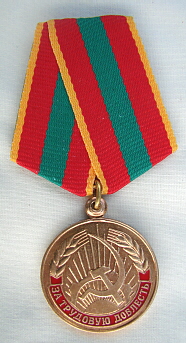 0
0 -
And the back... the cyrillic type is Pridnestrovskaia Moldavskaia Respublica.
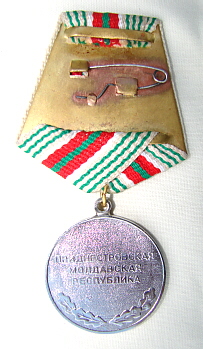 0
0 -
A detail of the front... note the country's seal within the Ministry of the Interior shield. The initials "PMR" are written in the three languages spoken; Russian, Moldovan and Ukrainian.
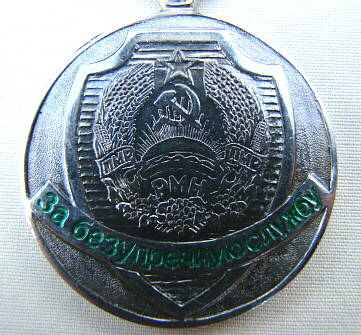 0
0 -
Pridnestrovie, or the Pridnestrovie Moldavian Republic, was refered to as Transniester (across the Dniester river) when a part of Moldova. In 1990-92 they fought for independence and established the Pridnestrovskaia Moldavskaia Respublica. Though not yet fully recognized, they seem well on the way in that direction. Check out at: pridnestrovie.net
Anyway, they have established a set of awards, two examples of which I'll show now. Note that they have chosen to keep the hammer and sickle motif on their state seal, coins and awards (from when they were a Soviet Socialist Republic) even though they are a multi-party democracy. Their flag is, basically, the Moldavian SSR flag with equal horizontal bands of red, green and red. The hammer and sickle is not on the flag.
The first is the Medal for Irreproachable Service, 3rd Class (10 years). Soviet-type suspension, nickle medal with "spot" clear enamel on front.
 0
0 -
And the inside of the 35 year document...
 0
0 -
The inside of the 30 year document...
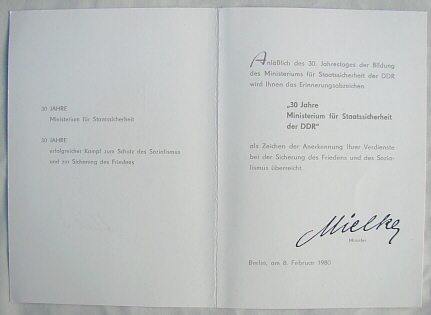 0
0 -
Recently acquired a couple of the certificates that accompanied these shield badges; one for 30 years and the other for 35. Both are type 1, according to Ralph Pickard's book, "Stasi Memorabilia". Both contain Mielke's stamped signature.
 0
0 -
I've been able to add a few more pieces to the group. I'll just show the display for now; if there are questions, I'll address those as they come in.
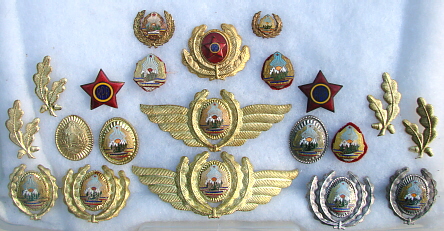 0
0 -
Hey Ed,
The lady on the left is wearing a diamond shaped (I assume an institute of higher learning) badge above her left pocket... do you have a better image of that badge? I'm seeing what I believe is some "red" at the very top (maybe a small star) and was wondering if this may have been awarded during the Socialist years.
0 -
Until the very last of the 40 year badges, the catch had been the same, and is shown here in the foreground. The last of the 40 year badges had a new, opposing tension type catch, seen in the background. This catch was also used on most, if not all, of the last medals and ribbons made in the DDR.
 0
0 -
And, finally, the 35 and 40 year shields. Note that the 40 year shield breaks with the roman numerals. Also note the pristine 40 year shield on the right- it remained wrapped up and boxed- unissued- until it was sold to me. It represents the very last of these shields made and has a different catch mechanism which I will show in my final post.
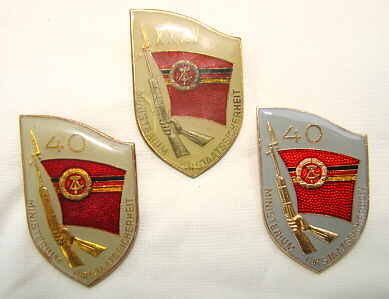 0
0 -
On to the 30 year shields. Note the slightly smaller odd man out on the left- this is a "muster"; a maker's sample for a new design. I've seen 3 proposal variations- this one, another which is identical except silver plated and with no white lacquer behind the type, and a third with "30" instead of XXX. Anyway, the new designs were rejected and the shield on the right is the one that was used.
 0
0 -
Next, the 20th and 25th shields. Note I have two 25's- the lower left is pretty standard while the ragged-out, later model on the lower right is actually important to the collection in that it signals the shift from bronze plating to gold plating, which would continue until the end. This particular shield may well have had a polyester coating on the front which, if it did, would have designated it for presentation to V.I.P.'s.
 0
0 -
First, the elusive un-numbered shield. The pin-backed version does not have the polyester coating on the front and it's also bronze (looks nearly copper in DDR items) plated- this is actually a flat-backed plaque that was used on gift items. I was originally disappointed that this was the only un-numbered shield I could find until Bartel's book pointed out that this was the rarer of the two.
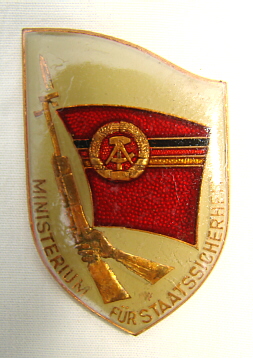 0
0 -
Here's my MfS Shield collection. It's as close to being complete as it's probably going to get- it lacks black, red and green versions of the 40 year shield. First, the group as a whole; then I'll post close-ups:
 0
0 -
No change; still Communist... in fact, the SED (Sozialistische Einheitspartei Deutschlands- Socialist Unity Party of Germany) which was the ruling party of the DDR has become the Party of Democratic Socialism or PDS. They run for seats in the Bundestag just like any other party and have won a few. The SED was a merger (forced by the USSR) of two parties; the KPD (Communist Party of Germany) and the SPD (Social Democratic Party of Germany). Both of these parties still exist as well.0
-
While I realize this thread is somewhat old (2007) there is something to say here; the FDJ still exists! Check out www.fdj.de
0 -
And nestled in it's blue, locking case with imprinted inner lid:
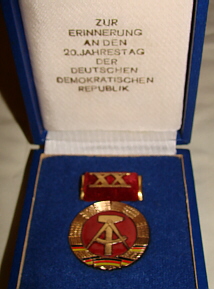 0
0 -
And the back (bad photography- sorry):
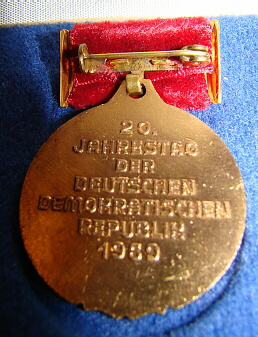 0
0 -
Here's the 20 Year DDR medal with case I latched onto awhile back. Wasn't sure of exactly what I had until I contacted Paul Bartel, who told me it should be classified as an SED honour award. Anyway, here it is:
 0
0 -
With regard to the colour of the DDR's Airborne beret; it simply matched the designated branch colour for Airborne troops. The rank insignia, uniform piping and beret were all done in this particular orange colour (except in the field, of course). This colour was the traditional colour of Airborne Troops since the Third Reich (the Luftwaffe Airborne used more or less the same colour). I doubt seriously that vanity was involved here.
Also, the beret's use was becoming more widespread for all branches toward the end of the DDR. The last proposed uniform change for the DDR placed everyone in a beret. So, all those pretty branch colours would have been "on parade" once the change was completed (which it wasn't) and everyone would have had a second, field-use beret.
It seems the DDR's idea latched on here in the states- everyone in the Army is now wearing a beret (albeit most are black). Certainly cheaper to produce and less cumbersome than the billed service cap, I still prefer the days when only one beret was seen- that colour was green and it meant something back then.
0 -
Doc,
I'm not going to say the other guy is wrong, but the overall shape of the board (thinner than the other Russian rounded-top boards) is more German than Russian and the rank pattern (such as it is here) is more German than Russian (stripe would be higher on the board). Still, it could be a coincidental similarity; especially when taking militias into account. Also, at that particular point in the GDR's history, a lot (if not all) of uniform supplies were coming from the USSR- a militia could have made use out of leftover, unused supplies at a later date.
0



Pridnestrovie!
in Central & Eastern European States
Posted
A couple of new additions to the collection... the first is the Order of Labour Glory (only one class). Nice, heavy construction; ribbon seems to borrow the dark blue/light blue of the Soviet Red Banner of Labour along side the colours of the Pridnestrovie flag (red-green-red).
A textured reverse with a maker's mark in the center that I cannot yet identify.